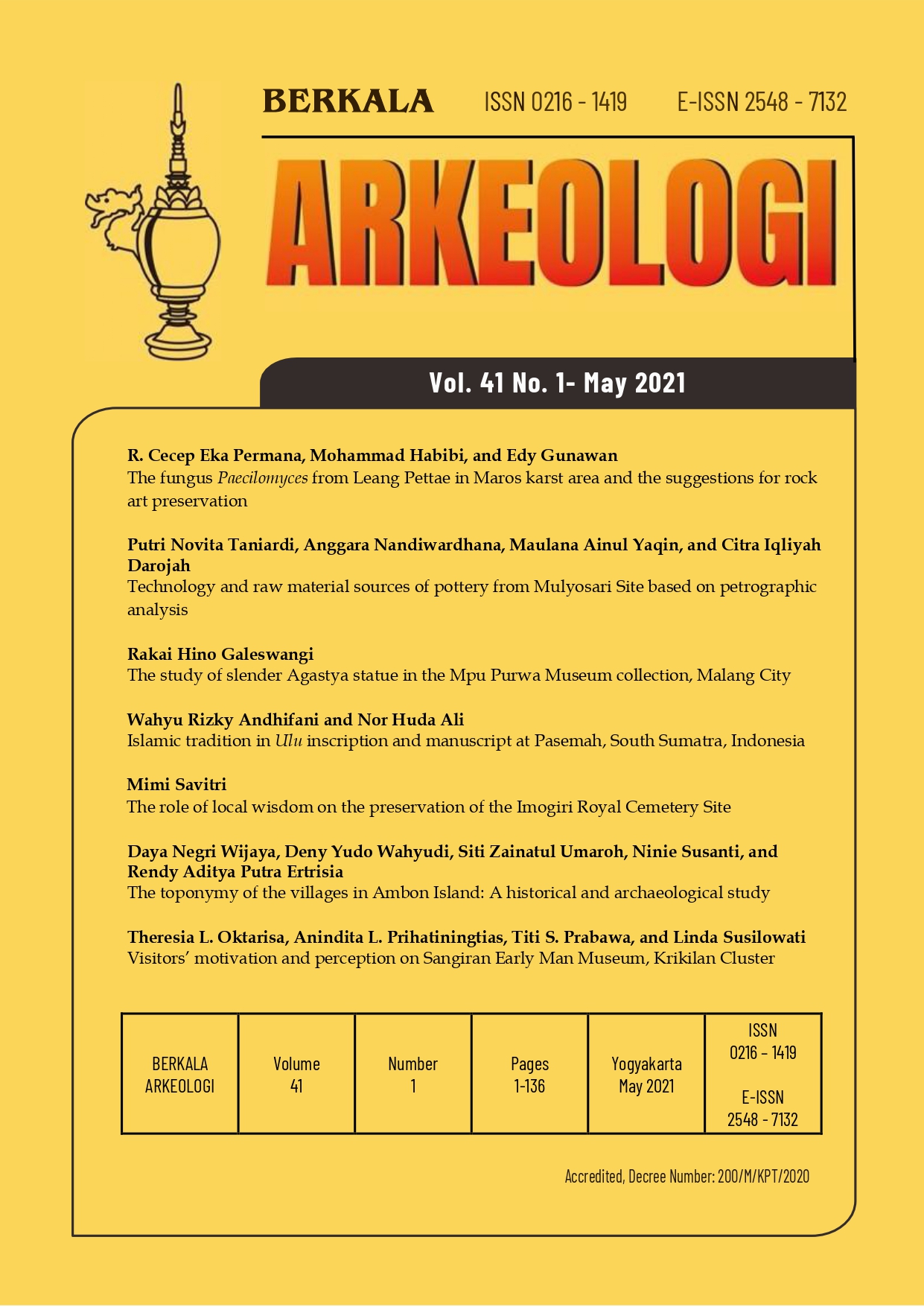The toponymy of the villages in Ambon Island: A historical and archaeological study Toponimi desa-desa di Nusa Ambon: Kajian sejarah dan arkeologi
Main Article Content
Abstract
Previously, several toponymy studies have already been conducted both in the Nusa (Island) Ambon as well as in the City of Ambon. However, previous studies have not used the historical and archaeological approach. The use of this approach could ease the researchers to reveal the cross-cultural meeting in a specific locus. Taking the Island of Ambon as a locus, the researchers aim to find the origin of village names and the cultural intersection in Leihitu and Leitimor Peninsula. There were three steps conducted to collect and analyse data using historical and archaeological approach. Firstly, the researchers identified and took a tabulation of the village names, mentioned by the Hikayat Tanah Hitu (The Epic of Hitu Land) and three ancient maps. Secondly, the researchers identified various archaeological remains located in the scattered villages. Finally, the researchers analysed the origin of village names by searching the word-meanings, finding the present locations, and describing the role of the contemporary cultures (Islamic and Colonial period) in the past. The researchers found 12 villages with 22 archaeological remains. All related communities have the archaeological remains which could explain the local dynamics, but there are merely ten villages which name meanings could be identified.
Article Details

This work is licensed under a Creative Commons Attribution-NonCommercial-ShareAlike 4.0 International License.
References
Abdurachman, P. (2008). Bunga angin Portugis di Nusantara: kejak-jejak kebudayaan Portugis di Indonesia. LIPI Press.
Balai Pelestarian Cagar Budaya Maluku Utara. (2011). Laporan inventarisasi cagar budaya kabupaten Maluku Tengah dan kota Ambon.
Balai Pelestarian Cagar Budaya Maluku Utara. (2014). Laporan zonasi balai pelestarian cagar budaya Maluku Utara.
Balai Pelestarian Cagar Budaya Maluku Utara. (2019). Laporan kegiatan kajian pelestarian kawasan cagar budaya negeri Soya kota Ambon.
Basman, A., Toisuta, H., Rajab, H., Wakano, A., & Baharudin, A. (2012). Sejarah sosial kerajaan Hitu Ambon. Kementerian Agama.
Da Franca, A. P. (2000). Pengaruh Portugis di Indonesia. Sinar Harapan.
De Castro, J. M. (2019). Lautan rempah peninggalan Portugis di Nusantara. Kompas Gramedia.
De Graaf, H. J. (1977). De geschiedenis van Ambon en de zuid Molukken. Uitgeveritj T. Wever.
Deliani, S. (2016). Toponimi kota Medan (dalam relativitas linguistik). Seminar Nasional Toponimi: Toponimi dalam Perspektif Ilmu Budaya, 266–270. https://linguistik.fib.ui.ac.id/seminar-toponimi/
Direktorat Jendral Kependudukan dan Catatan Sipil Kementerian Dalam Negeri. (2017). Data kependudukan provinsi Maluku per semester 1 bulan juni tahun 2017.
Direktorat Pelindungan Kebudayaan. (n.d.). Sistem registrasi cagar budaya nasional. http://cagarbudaya.kemdikbud.go.id/
Handoko, W. (2014). Tradisi nisan menhir pada makam kuno raja-raja di wilayah kerajaan Hitu. Kapata Arkeologi, 10(1), 33–46. https://doi.org/10.24832/kapata.v10i1.216
Keuning, J. (2016). Sejarah Ambon sampai akhir abad ke-17. Ombak.
Leirissa, R. ., Ohorella, G. A., & Latuconsina, D. (1999). Sejarah kebudayaan Maluku. Departemen Pendidikan dan Kebudayaan.
Leirissa, R. ., Pattikayhatu, J. A., Luhukay, H., Talib, U., & Maelissa, S. (2004). Ambonku dulu, kini, dan esok. Pemerintah Kota Ambon.
Mansyur, S. (2012). Peran wilayah negeri Larike pada masa kolonial. Kapata Arkeologi, 8(2), 65–72. https://doi.org/10.24832/kapata.v8i2.188
Manuhutu, F. S. (2002). Toponimi di kota Ambon: laporan penelitian.
Manusama, Z. J. (1977). Hikayat tanah Hitu: historie en sociale van de Ambonse Elanden in het algemeen en van Uli Hitu in het bijzonder tot het midden der zeventiende eeuw. Rijksuniversiteit te Leiden.
Munandar, A. A. (2016). Toponimi dalam kajian arkeologi. Seminar Nasional Toponimi: Toponimi dalam Perspektif Ilmu Budaya, 1–26. https://linguistik.fib.ui.ac.id/seminar-toponimi/
Pattikayhatu, J. A. (2008). Sekilas kota Ambon dan provinsi Maluku. Citra Aji Parama.
Pusat Dokumentasi Arsitektur. (n.d.). Benteng Indonesia. http://benteng.architectureheritage.or.id
Rais, J., Lauder, M., Sudjiman, P., Ayatrohaedi, Sulistyo, B., Wiryaningsih, A., Suparwati, T., & Santoso, W. E. (2008). Toponimi Indonesia: sejarah budaya yang panjang dari permukiman manusia & tertib administrasi. Pradnya Paramita.
Suratminto, L. (2016). Nama-nama tempat di Jakarta dan kaitannya dengan masa kolonial. 37–54. https://linguistik.fib.ui.ac.id/seminar-toponimi/
Wattimena, L. (2009). Rumah adat Baileo: interpretasi budaya di negeri Hutumuri kecamatan Leitimur Selatan kota Ambon. Kapata Arkeologi, 5(8), 23–34. https://doi.org/10.24832/kapata.v5i8.107
Widyastuti, M. (2016). Penyebutan makam di dalam masyarakat Jawa. Seminar Nasional Toponimi: Toponimi dalam Perspektif Ilmu Budaya, 196–207. https://linguistik.fib.ui.ac.id/seminar-toponimi/

